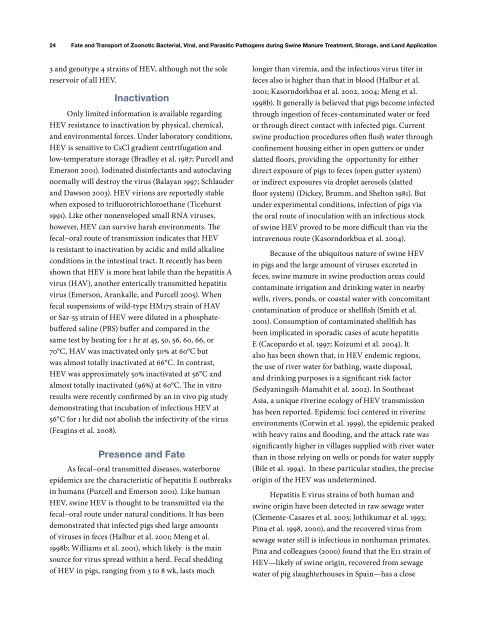Fate and Transport of Zoonotic Bacterial, Viral, and - The Pork Store ...
Fate and Transport of Zoonotic Bacterial, Viral, and - The Pork Store ...
Fate and Transport of Zoonotic Bacterial, Viral, and - The Pork Store ...
You also want an ePaper? Increase the reach of your titles
YUMPU automatically turns print PDFs into web optimized ePapers that Google loves.
24<br />
<strong>Fate</strong> <strong>and</strong> <strong>Transport</strong> <strong>of</strong> <strong>Zoonotic</strong> <strong>Bacterial</strong>, <strong>Viral</strong>, <strong>and</strong> Parasitic Pathogens during Swine Manure Treatment, Storage, <strong>and</strong> L<strong>and</strong> Application<br />
3 <strong>and</strong> genotype 4 strains <strong>of</strong> HEV, although not the sole<br />
reservoir <strong>of</strong> all HEV.<br />
Inactivation<br />
Only limited information is available regarding<br />
HEV resistance to inactivation by physical, chemical,<br />
<strong>and</strong> environmental forces. Under laboratory conditions,<br />
HEV is sensitive to CsCl gradient centrifugation <strong>and</strong><br />
low-temperature storage (Bradley et al. 1987; Purcell <strong>and</strong><br />
Emerson 2001). Iodinated disinfectants <strong>and</strong> autoclaving<br />
normally will destroy the virus (Balayan 1997; Schlauder<br />
<strong>and</strong> Dawson 2003). HEV virions are reportedly stable<br />
when exposed to trifluorotrichloroethane (Ticehurst<br />
1991). Like other nonenveloped small RNA viruses,<br />
however, HEV can survive harsh environments. <strong>The</strong><br />
fecal–oral route <strong>of</strong> transmission indicates that HEV<br />
is resistant to inactivation by acidic <strong>and</strong> mild alkaline<br />
conditions in the intestinal tract. It recently has been<br />
shown that HEV is more heat labile than the hepatitis A<br />
virus (HAV), another enterically transmitted hepatitis<br />
virus (Emerson, Arankalle, <strong>and</strong> Purcell 2005). When<br />
fecal suspensions <strong>of</strong> wild-type HM175 strain <strong>of</strong> HAV<br />
or Sar-55 strain <strong>of</strong> HEV were diluted in a phosphatebuffered<br />
saline (PBS) buffer <strong>and</strong> compared in the<br />
same test by heating for 1 hr at 45, 50, 56, 60, 66, or<br />
70°C, HAV was inactivated only 50% at 60°C but<br />
was almost totally inactivated at 66°C. In contrast,<br />
HEV was approximately 50% inactivated at 56°C <strong>and</strong><br />
almost totally inactivated (96%) at 60°C. <strong>The</strong> in vitro<br />
results were recently confirmed by an in vivo pig study<br />
demonstrating that incubation <strong>of</strong> infectious HEV at<br />
56°C for 1 hr did not abolish the infectivity <strong>of</strong> the virus<br />
(Feagins et al. 2008).<br />
Presence <strong>and</strong> <strong>Fate</strong><br />
As fecal–oral transmitted diseases, waterborne<br />
epidemics are the characteristic <strong>of</strong> hepatitis E outbreaks<br />
in humans (Purcell <strong>and</strong> Emerson 2001). Like human<br />
HEV, swine HEV is thought to be transmitted via the<br />
fecal–oral route under natural conditions. It has been<br />
demonstrated that infected pigs shed large amounts<br />
<strong>of</strong> viruses in feces (Halbur et al. 2001; Meng et al.<br />
1998b; Williams et al. 2001), which likely is the main<br />
source for virus spread within a herd. Fecal shedding<br />
<strong>of</strong> HEV in pigs, ranging from 3 to 8 wk, lasts much<br />
longer than viremia, <strong>and</strong> the infectious virus titer in<br />
feces also is higher than that in blood (Halbur et al.<br />
2001; Kasorndorkbua et al. 2002, 2004; Meng et al.<br />
1998b). It generally is believed that pigs become infected<br />
through ingestion <strong>of</strong> feces-contaminated water or feed<br />
or through direct contact with infected pigs. Current<br />
swine production procedures <strong>of</strong>ten flush water through<br />
confinement housing either in open gutters or under<br />
slatted floors, providing the opportunity for either<br />
direct exposure <strong>of</strong> pigs to feces (open gutter system)<br />
or indirect exposures via droplet aerosols (slatted<br />
floor system) (Dickey, Brumm, <strong>and</strong> Shelton 1981). But<br />
under experimental conditions, infection <strong>of</strong> pigs via<br />
the oral route <strong>of</strong> inoculation with an infectious stock<br />
<strong>of</strong> swine HEV proved to be more difficult than via the<br />
intravenous route (Kasorndorkbua et al. 2004).<br />
Because <strong>of</strong> the ubiquitous nature <strong>of</strong> swine HEV<br />
in pigs <strong>and</strong> the large amount <strong>of</strong> viruses excreted in<br />
feces, swine manure in swine production areas could<br />
contaminate irrigation <strong>and</strong> drinking water in nearby<br />
wells, rivers, ponds, or coastal water with concomitant<br />
contamination <strong>of</strong> produce or shellfish (Smith et al.<br />
2001). Consumption <strong>of</strong> contaminated shellfish has<br />
been implicated in sporadic cases <strong>of</strong> acute hepatitis<br />
E (Cacopardo et al. 1997; Koizumi et al. 2004). It<br />
also has been shown that, in HEV endemic regions,<br />
the use <strong>of</strong> river water for bathing, waste disposal,<br />
<strong>and</strong> drinking purposes is a significant risk factor<br />
(Sedyaningsih-Mamahit et al. 2002). In Southeast<br />
Asia, a unique riverine ecology <strong>of</strong> HEV transmission<br />
has been reported. Epidemic foci centered in riverine<br />
environments (Corwin et al. 1999), the epidemic peaked<br />
with heavy rains <strong>and</strong> flooding, <strong>and</strong> the attack rate was<br />
significantly higher in villages supplied with river water<br />
than in those relying on wells or ponds for water supply<br />
(Bile et al. 1994). In these particular studies, the precise<br />
origin <strong>of</strong> the HEV was undetermined.<br />
Hepatitis E virus strains <strong>of</strong> both human <strong>and</strong><br />
swine origin have been detected in raw sewage water<br />
(Clemente-Casares et al. 2003; Jothikumar et al. 1993;<br />
Pina et al. 1998, 2000), <strong>and</strong> the recovered virus from<br />
sewage water still is infectious in nonhuman primates.<br />
Pina <strong>and</strong> colleagues (2000) found that the E11 strain <strong>of</strong><br />
HEV—likely <strong>of</strong> swine origin, recovered from sewage<br />
water <strong>of</strong> pig slaughterhouses in Spain—has a close


